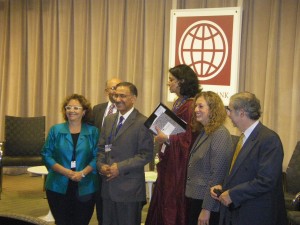At a recent World Bank event in Washington, D.C., policymakers and other stakeholders met to discuss the food challenges facing the South Asian region. There are 336 million people chronically hungry and 46 percent of children under the age of five suffer from malnutrition, much higher than sub-Saharan Africa’s 26 percent.

According to World Bank Chief Economist for South Asia, Kalpana Kochhar , more than one-third of all child deaths in the region are due to malnutrition, mostly because malnutrition increases the likelihood of dying from other diseases. Economically, micronutrient deficiencies are estimated to put a strain on many South Asian countries—annually, Afghanistan is estimated to lose $235 million, Pakistan is estimated to lose $3 billion, and India is estimated to lose a whopping $12 billion in GDP.
But this was not a discussion focused solely on the problems. Also in attendance was Santiago Levy, Vice President for Sectors and Knowledge in the Inter-American Development Bank, who discussed the successes of a government-led program called Programa de Educación, Salud y Alimentación (PROGRESA), which was aimed to address poverty and food insecurity in Mexico. After Mexico’s economic downturn in the mid 1990s, when 30 percent of Mexicans were suffering from extreme poverty, Mexico’s finance ministers established the program as a means of addressing the problem. Through conditional cash transfer programs, where families received money if they fulfilled certain requirements – children attended sufficient amount of classes, women made sufficient number of trips to clinics, and other criteria – Mexico was able to reduce the number of people suffering from malnutrition.
Levy pointed out that because of the program food consumption rates had increased by 72 percent, calorie intake had increased by almost 8 percent, and infant mortality rates had significantly declined. The program also has a high rate of return – it relies on only 5 percent of the country’s GDP to function, but serves 20 percent of the country’s households.
Mehmood Khan, the CEO of Pepsico‘s Global Nutrition Group stated that because 95 percent of the world’s population purchases food from the private sector, it was important that business and corporations were also included in the conversation on food insecurity. With such a wide reach, they provide a great outlet for people around the world to access nutritious food, and there are already some examples of success. Under the direction of Khan, Pepsico conducted a pilot project in India, where they released an energy drink aimed to combat iron deficiency in young women. This product has already produced some promising results – 96 percent of the children introduced to the product are now aware about iron deficiency and ways that they can address it.
Notably missing from the meeting were finance and economic ministers of these South Asian countries who would play paramount roles in implementing any federal programs to address nutrition. But as malnutrition continues to hurt these growing economies (see GDP losses above), all the participants who attended hope and expect food security to become a central issue in South Asian government policy.
By Supriya Kumar

Danielle Nierenberg, an expert on livestock and sustainability, currently serves as Project Director of State of World 2011 for the Worldwatch Institute, a Washington, DC-based environmental think tank. Her knowledge of factory farming and its global spread and sustainable agriculture has been cited widely in the New York Times Magazine, the International Herald Tribune, the Washington Post, and
other publications.
Danielle worked for two years as a Peace Corps volunteer in the Dominican Republic. She is currently traveling across Africa looking at innovations that are working to alleviate hunger and poverty and blogging everyday at Worldwatch Institute’s Nourishing the Planet. She has a regular column with the Mail & Guardian, the Kansas City Star, and the Huffington Post and her writing was been featured in newspapers across Africa including the Cape Town Argus, the Zambia Daily Mail, Coast Week (Kenya), and other African publications. She holds an M.S. in agriculture, food, and environment from Tufts University and a B.A. in environmental policy from Monmouth College.








